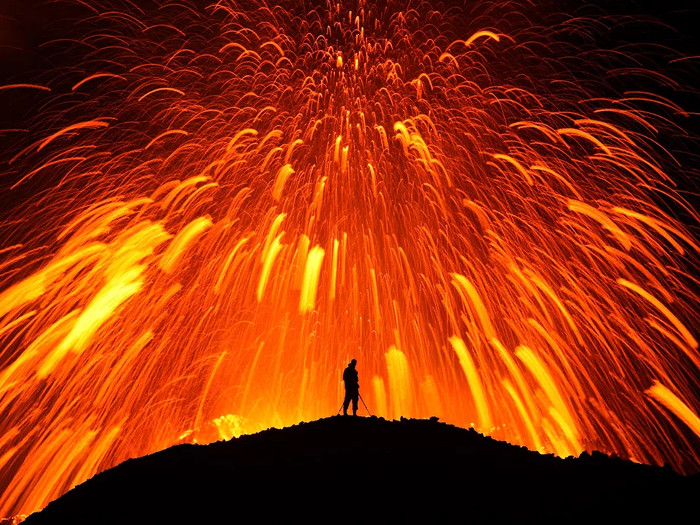People can escape super volcanoes only by cars
New research by US scientists indicates if super volcanoes suddenly erupt, humans are fully capable of escaping using cars.
In a study published March 7 in the journal Nature Communication, US researchers concluded that people living near the volcano need only a few hours to evacuate before the eruption . According to Live Science, by analyzing the remnants of a volcanic eruption, scientists discovered lava moving in the street at speeds of 16 - 72km / h. People are difficult to achieve this speed when jogging, but if you use a car, it is possible.
"I do not encourage anyone to try to race against the erupting volcano, however, some of us have that ability," said Greg Valentine, a volcanic researcher from New York University in Buffalo, Research co-author, said.

Lava erupts from the mouth of a volcano in Iceland.(Photo: Caters News).
The safest way to deal with any volcanic eruption is to go as far as possible. Long distance helps people avoid lava flows, blocks of ice and extremely hot air flow with a speed of up to 480km / h. Rock and hot air sprayed at high speed forming the flow of pyroclastic flows , the true culprit robbed many lives instead of lava.
A stream of pyroclastic flow from the volcano Vesuvius once buried the Roman town of Pompeii in 79. In 1902, in an eruption of Pelée volcano on Martinique island, pyroclastic flow itself caused the death of 29,000 people.
18.8 million years ago, a super volcano erupted in Arizona, USA, accompanied by volcanic ash spread over 160km. The rock forms from volcanic ash more than 140m thick in places near the mouth of the mountain and 3 m thick in the farthest place, called the Peach Springs volcanic rock layer. The researchers took stone samples from the lower part of the Peach Rings and compared them to the rock form inside the volcano. They found the distance they were swept away was no more than the length of a football field.
The size and location of the rock samples helps researchers build models that explain the speed and thickness of volcanic ash. According to the team, the pyroclastic flow must be thick and move at a slow speed so that it can be carried along with the rocks. A thin pyroclastic flow must reach 2,340 km / h to be able to do this.
"It is interesting to find such a terrible volcanic eruption that produces slow moving currents," Valentine said. "They are slow, dense and heavy but still capable of devastating a large area."
- 4 super volcanoes threaten humanity
- Super volcano discovered in Hong Kong
- Scary volcanoes are more than meteorites
- 'Super volcano' formed faster than expected
- The risk of activating super volcanoes can kill millions
- See active volcanoes around the world
- This great invention is the solution to save hundreds of people in the sea of fire
- Traces of ancient super volcanoes in Utah
- Super volcanoes capable of causing apocalypse are forming
- The first car in the world is ... 3D printing
- Video: How have cars changed in the last 100 years?
- The undersea volcano can explode
 'Fine laughs' - Scary and painful torture in ancient times
'Fine laughs' - Scary and painful torture in ancient times The sequence of numbers 142857 of the Egyptian pyramids is known as the strangest number in the world - Why?
The sequence of numbers 142857 of the Egyptian pyramids is known as the strangest number in the world - Why? History of the iron
History of the iron What is alum?
What is alum?